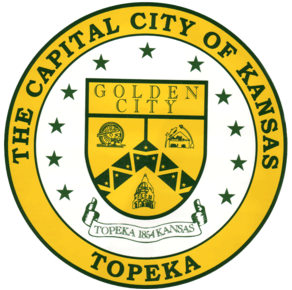|
Geotag (location) for: Topeka: 39º2'5"N;95º41'44"W
Topeka (KS) cityTopeka (kansa: Tó Ppí Kˀé) är huvudstad i Kansas och centralort i Shawnee County, USA. Staden är belägen längs med Kansasfloden i centrala delen av Shawnee County, i nordöstra Kansas. Enligt 2020 års folkräkning hade staden 126 587 invånare. Washburn University är beläget i staden. Översikt
Topeka city i Shawnee county i Kansas i USA
Arkiv: Shawnee County, Kansas Genealogy
Historik
ÖvrigtThe name ”Topeka” is a Kansa-Osage word that means ”place where we dig potatoes”, or ”a good place to dig potatoes”. As a placename, Topeka was first recorded in 1826 as the Kansa name for what is now called the Kansas River. Topeka's founders chose the name in 1855 because it ”was novel, of Indian origin, and euphonious of sound.” Mixed-heritage Kansa Native American, Joseph James, called Jojim, is credited with suggesting Topeka's name. Along with Cheyenne, Wyoming and Oklahoma City, Oklahoma, Topeka is one of three state capitals with an indigenous name in a state with an indigenous name. |
består av
|
Användarverktyg
plats:us:topeka.ks.city
plats/us/topeka.ks.city.txt · Senast uppdaterad: 2024/04/03 01:27 av 127.0.0.1

